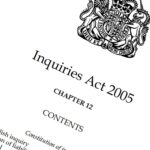The government makes all the rules, executes them, and prosecutes whoever disobeys the law. The police are expected to enforce the laws of the land. And when all diplomatic ways of curbing crime fail, they use force to alleviate the problems of crime somehow.
In this article, we will see how the UK police use force to maintain peace and order and the public perception of the police’s use of force. Does the police force use force in a just, humane manner?
How Does the Police Use Force?
Police’s use of force is nothing new in their protocols. This act is even backed up by law, per the Criminal Law Act of 1967, Section 3. It states that “A person may use such force as is reasonable in the circumstances in the prevention of crime, or in effecting or assisting in the lawful arrest of offenders or suspected offenders or of persons unlawfully at large.” Not only the police force can make such arrests, but virtually all the citizens of the UK. Such force may be used for self-defense, defense of another person, defense of property, crime prevention, and lawful arrest. The Crown Prosecution Services (CPS) adds some provisions on the last two instances, as necessity may not be equated with rationality. These are some of the factors that must be considered:
- the nature and degree of force used;
- the seriousness of the offense which is being prevented or in respect of which an arrest is being made; and
- the nature and degree of any force used against an officer by a person resisting arrest
- Information about guidance or training that an officer has received may be used to determine what is reasonable.
The police usually utilize three ways of restraining violence on rowdy people. Here are the three methods:
- Physical restraint (such as arm locks and pressure compliance)
- Batons and incapacitant sprays (e.g., “pepper spray”)
- Firearms, tasers, and other restraining equipment
Public Perceptions on Police’s Use of Force
The police force has been notorious for being “abusive” and “unjust.” Does this claim hold true? In this part, we will reveal some statistics that reflect how the public perceives the police’s use of force.
A 2015 survey conducted by the research agency TNS BMRB on behalf of the then-IPCC (now Independent Office for Police Conduct or IOPC) shows a staggering amount of support by the citizens on the reasonable use of force. 83% of those surveyed agree to the police’s use of force, as long as it is rational and humane. Older people (age 55+) have the highest regard for the police’s use of force. Meanwhile, the minority population that consists of people of African and other descent and the people of London are not that convinced that the police use force justly. As expected, people who experienced the police’s use of force have opposing views on such action.
The public had limited awareness of what the police can legally use on law enforcement, but they have high trust that the police will abide by the laws. They also think that the key considerations of the police’s use of force are the aim, risk, and impact of using force to ensure compliance with the law. The people surveyed also agree that personal characteristics must not affect how the police’s decision-making unless it impacts the vulnerability and physicality of an individual. The vulnerability of an individual (e.g., mental health concerns) must also be taken into account when using force.
When it comes to the readiness of the police, under half of the people surveyed, agree that the police are more than ready to use force compared to 10 years ago, whereas a third say otherwise. A quarter is concerned about how the police use force, while 1 out of 25 people have more severe concerns regarding the police’s use of force.
The public perceives that the police use force in high-risk situations that may harm the public, individual, or the police themselves. The people also see the police use firearms rarely, though they feel that the police use these four times more often than reality.
Lastly, people also believe that no particular type of force is superior to others, and the use of force is generally accepted in several situations
Some Insights on Police’s Use of Force (News Articles)
With the COVID-19 pandemic still ravaging worldwide, we may expect that the police will use force less, as criminals are “afraid” of getting the contagious disease, and everyone is in lockdown. However, this is not the case. According to The Guardian’s article, although there was a 15% decline in the crime rate, there was a 12.5% increase in the use of force from April to June 2020. The National Police Chiefs Council (NPCC) defends this intensification of the use of force as “greater proactive policing against known criminals.” But critics are not swayed by this rhetoric, as they claim that the police are currently using this pandemic as a strategy “to selectively reassert an aggressive, command-and-control style of policing.” The Met police’s spokesperson reaffirmed the statement of NPCC that says they are increasing police activity for proactivity, thus the increase of police’s use of force despite the pandemic.
In a more recent article by the BBC, the police’s use of force is said to differ among black and white people. The article reports that the British Transport Police officers used force 6,325 times from 2019 to 2020, with one in five cases involving black people. Based on the figures from the Department for Transport (DfT), this shows that black people will be six times more likely to experience police’s use of force. Figures also show 17.5% of all methods of use-of-force involved black people.
Overall, the public trust in the police is still high, though there are still doubts on how the police practice force in law enforcement. The public still believes the police are impartial in enforcing laws, though we must still be observant. With the rise of the use of police force in these trying times, we must check if they really practice the use of force in accordance to laws. Do not be afraid of reporting police abuse to the proper authorities, so they may be disciplined accordingly.
This article was prepared by the Association Against Abuse of Police Powers and Privileges (AAAPPP), a UK not-for-profit organisation specializing in assisting victims of abuse of power and corruption in the UK Police.






Thanks for this post, I am a big big fan of this web site would like to continue updated.
You made a number of good points there. I did a search on the subject and found mainly people will consent with your blog.
F*ckin¦ tremendous things here. I¦m very glad to look your article. Thank you a lot and i’m looking ahead to touch you. Will you kindly drop me a mail?
Hi there, I found your site via Google while searching for a related topic, your site came up, it looks great. I have bookmarked it in my google bookmarks.
Thanks for any other informative website. The place else may just I am getting that kind of info written in such a perfect way? I’ve a project that I’m simply now running on, and I’ve been on the look out for such information.
I am often to blogging and i really appreciate your content. The article has really peaks my interest. I am going to bookmark your site and keep checking for new information.
I want to show my love for your kindness giving support to folks who require assistance with this important issue. Your personal commitment to getting the message all-around appears to be certainly good and has truly encouraged individuals like me to arrive at their desired goals. The valuable hints and tips entails much to me and even further to my mates. Regards; from all of us.
Great post. I am facing a couple of these problems.
Magnificent web site. Lots of helpful info here. I’m sending it to a few buddies ans additionally sharing in delicious. And naturally, thank you on your effort!
I don’t even know how I ended up here, but I thought this post was good. I do not know who you’re but certainly you’re going to a well-known blogger when you aren’t already 😉 Cheers!
It is actually a great and helpful piece of info. I am happy that you simply shared this useful info with us. Please stay us up to date like this. Thanks for sharing.
I have been reading out a few of your stories and i can state pretty nice stuff. I will surely bookmark your blog.
Rattling clean web site, thanks for this post.
I really like your writing style, great information, regards for posting : D.
Hi there! I could have sworn I’ve been to this blog before but after browsing through some of the post I realized it’s new to me. Anyways, I’m definitely glad I found it and I’ll be bookmarking and checking back often!
I have recently started a site, the info you provide on this website has helped me tremendously. Thank you for all of your time & work.
Hi my friend! I wish to say that this article is amazing, nice written and include almost all vital infos. I would like to see more posts like this.
Very interesting information!Perfect just what I was looking for!
I’m very happy to read this. This is the type of manual that needs to be given and not the random misinformation that is at the other blogs. Appreciate your sharing this greatest doc.
It’s actually a nice and helpful piece of information. I am glad that you shared this useful info with us. Please keep us up to date like this. Thanks for sharing.
As I website owner I conceive the content material here is real wonderful, regards for your efforts.
Its fantastic as your other posts : D, regards for posting.
Hello! I just would like to give a huge thumbs up for the great info you have here on this post. I will be coming back to your blog for more soon.
Woah! I’m really digging the template/theme of this site. It’s simple, yet effective. A lot of times it’s very difficult to get that “perfect balance” between superb usability and visual appearance. I must say you’ve done a fantastic job with this. Additionally, the blog loads extremely quick for me on Internet explorer. Exceptional Blog!
you’re really a good webmaster. The site loading speed is amazing. It seems that you’re doing any unique trick. Furthermore, The contents are masterpiece. you’ve done a excellent job on this topic!
Thanks – Enjoyed this post, can you make it so I receive an email sent to me when you write a fresh update?
I like what you guys are up also. Such intelligent work and reporting! Carry on the excellent works guys I have incorporated you guys to my blogroll. I think it’ll improve the value of my website 🙂
I like the efforts you have put in this, appreciate it for all the great articles.
I must say you’ve been a big help to me. Thanks!
Thank you for writing this article!
Thank you for your help. I must say you’ve been really helpful to me.
You helped me a lot with this post. I love the subject and I hope you continue to write excellent articles like this.
Thank you for writing this post!
Thank you for another informative blog. Where else could I get that type of info written in such an ideal way? I’ve a project that I am just now working on, and I’ve been on the look out for such info.
It?s onerous to find educated people on this matter, however you sound like you recognize what you?re speaking about! Thanks
Spot on with this write-up, I truly think this website needs far more consideration. I?ll most likely be once more to learn much more, thanks for that info.
Hi my loved one! I want to say that this article is awesome, nice written and include almost all significant infos. I¦d like to look more posts like this .
Usually I do not read post on blogs, but I would like to say that this write-up very forced me to try and do it! Your writing style has been amazed me. Thanks, very nice post.
Wow! This could be one particular of the most helpful blogs We have ever arrive across on this subject. Actually Wonderful. I’m also an expert in this topic so I can understand your hard work.
Hello aaappp.org.uk admin, Your posts are always on topic and relevant.
Thank you for sharing superb informations. Your website is so cool. I’m impressed by the details that you?ve on this site. It reveals how nicely you understand this subject. Bookmarked this web page, will come back for extra articles. You, my pal, ROCK! I found simply the information I already searched all over the place and just couldn’t come across. What an ideal web site.
Wow, amazing weblog format! How lengthy have you ever been blogging for? you make blogging look easy. The full glance of your website is great, as smartly as the content!
Hello there, You’ve done an incredible job. I will certainly digg it and for my part suggest to my friends. I’m confident they will be benefited from this site.
I really appreciate this post. I?ve been looking everywhere for this! Thank goodness I found it on Bing. You have made my day! Thank you again
A person necessarily help to make critically articles I might state. That is the very first time I frequented your web page and so far? I amazed with the analysis you made to make this actual submit incredible. Excellent job!
Normally I do not read post on blogs, but I wish to say that this write-up very forced me to try and do so! Your writing style has been surprised me. Thanks, quite nice article.
Normally I don’t learn post on blogs, however I would like to say that this write-up very forced me to take a look at and do so! Your writing taste has been surprised me. Thank you, very great article.
This actually answered my problem, thank you!
Pretty nice post. I just stumbled upon your blog and wished to mention that I have truly loved browsing your blog posts. After all I?ll be subscribing on your rss feed and I am hoping you write again very soon!
great publish, very informative. I’m wondering why the other specialists of this sector don’t notice this. You must continue your writing. I am sure, you’ve a great readers’ base already!
Thanks a bunch for sharing this with all of us you actually know what you’re talking about! Bookmarked. Please also visit my website =). We could have a link exchange agreement between us!
Lovely site! I am loving it!! Will come back again. I am taking your feeds also.
Your article helped me a lot, is there any more related content? Thanks!